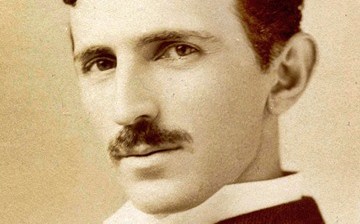Video on the genius of Nikola Tesla
Blogpost/Transcript – The Man Who Saw The Future – Nikola Tesla
Before Elon Musk and Tesla, there was the man, who inspired Musk and his company. Nikola Tesla the scientist who saw the future.
Tesla was born on July 10, 1856, in the village of Smiljan in the Austrian Empire into a Serbian family. He was an inventor, engineer and futurist, best known for his contributions to the development of the alternating current electricity supply system and for his rivalry with Thomas Edison.
His father was an orthodox priest and his mother was adept at making home craft tools and mechanical appliances. His professor’s demonstrations in high school developed his interest in electricity and his eidetic memory enabled him to do integral calculus in his head, making his teachers think that he was cheating.
(Check out Mathematician and Computer Programmer Ada Lovelace)
Tesla attended the Austrian Polytechnic in Graz, during which time he said that he worked from 3 am to 11 pm. In fact, his professors wrote to his father telling him to remove Tesla from the school or he would die of overwork. At this point, he also became addicted to gambling losing his scholarship and tuition money although he said later that he had conquered his addiction. However, he did not graduate from the school because he was unprepared for the exams and so he broke all contact with his family because he did not want them to know that he had dropped out.
In 1881, he moved to Budapest, Hungary to work at the Budapest Telephone Exchange. In 1882, Tesla moved to Paris to work with the Continental Edison Company, where he worked to install indoor lighting and got experience in electrical engineering.
(Check out Astronomer Cecilia Payne Gaposchkin)
In 1884, his manager went back to the US to manage the Edison Machine Works and he took Tesla along with him. Just like in Paris, in Manhattan, where Edison Machine Works was located, Tesla worked on troubleshooting installations and on improving generators. He left the company after six months, writing that he was promised 50,000 dollars to design 24 different types of machines but this turned out to be a joke. Some stories also say that Edison himself had offered him this amount to improve Edison’s DC generation plants but then later reneged telling Tesla that he did not understand American humour.
Tesla then obtained financing to start up the Tesla Light & Manufacturing and starting working to improve the DC generator and developed his ideas for the new types of alternating current motors and transmission equipment. But then investors left the company, leaving Nikola Tesla penniless.
In 1887, he set up the Tesla Electric Company in Manhattan after getting new financial backing and here he developed an induction motor, which ran on alternating current. His business partner was able to patent and publicize this motor and the Westinghouse Electric & Manufacturing company bought the license for the motor and transformer designs. Westinghouse even hired Tesla for one year. This was 1888, an extremely competitive time for electric companies, which included Westinghouse and Thomas Edison’s company. This was also the time of the famous “war of the currents” campaign, which grew out of the competing lighting systems i.e the low voltage direct current and the high voltage alternating current. Westinghouse was promoting alternating current by using transformers for indoor lighting and to transmit power more efficiently over large distances. However, Westinghouse was in financial trouble and he appealed to Tesla, who tore up the royalty contract with Westinghouse, giving up on billions of dollars’ worth of future royalties and even what he was already owed in license fees. Eventually, Westinghouse paid Nikola Tesla 216,000 dollars for the patent of his induction motor. On the other side, Edison was promoting direct current, saying that alternating current was dangerous. He was convinced that it would one day kill someone and would take many years to develop. No doubt, there were some deaths associated with alternating current, which further fuelled a panic, blaming Westinghouse for the deaths. Eventually, the “electric wars’ died down and alternating current became the norm and are considered Tesla’s legacy
Meanwhile, Tesla used the 216,000 dollars he got from Westinghouse to pursue his own interests. In 1889, he visited the world fair in Paris, learning about Heinrich Hertz’s experiments proving the existence of electromagnetic radiation and radio waves. He then designed the Tesla Coil, an electrical resonant transformer circuit in 1891. A Tesla Coil is used to produce high voltage, low current, high-frequency alternating current electricity and could also be used to send and receive radio signals (btw Tesla beat Marconi in getting a patent for radio transmission). He used the Tesla Coil to conduct experiments in lighting, x-ray generation and wireless transmission of electrical energy. His coils were used in radio transmitters & wireless telegraphy until the 1920s. During this time, Tesla also consulted on what system would be best to transmit power at the Niagara Falls.
(Check out A Brief History of Radio)
The Nikola Tesla Company was formed in 1895 and handled all of Tesla’s patents for decades. But then his lab caught fire in March 1895 and completely burned down, destroying his projects and research material. This was a very hard time for Nikola Tesla and he was devastated with this loss.
He rebuilt his lab and then experimented with x-rays (taking an x-ray of his hand) and radio remote control. He even demonstrated a remote controlled boat in 1898.
But Tesla’s dream was wireless transmission of power and communication and he spent a lot of time, energy and funds on this. He persuaded J.P Morgan to fund his giant Wardenclyffe transmission tower, predicting that the tower would be able to transmit communication across the globe. He said that an “inexpensive instrument, not bigger than a watch, will enable its bearer to hear anywhere, on sea or land, music or song, the speech of a political leader, the address of an eminent man of science, or the sermon of an eloquent clergyman, delivered in some other place, however distant. In the same manner any picture, character, drawing or print can be transferred from one to another place. Millions of such instruments can be operated from but one plant of this kind.” Basically, he predicted the world wide web as well as the smart phone and thought he could create it.
Once again, he ran out of money and this is the time Marconi was gaining fame. When Marconi sent his first ever radio transmission in 1901, Tesla complained that he had used 17 of his patents. He sued Marconi and lost and it was eventually in 1943, after Tesla died, that the US Supreme court upheld Tesla’s claims and his contribution to radio communication. The uncompleted Wardenclyffe tower became a relic and Tesla started withdrawing from the world.
He started showing signs of obsessive-compulsive disorder and high functioning autism, shaking hands with people three times and then washing them three times and he always had to have 18 napkins at his table.
Towards the end of his life, he became obsessed with pigeons, especially a white female that he claimed to love as one would love a human being. When the pigeon died, Tesla claimed that he knew that he had finished his life’s work. He worked from 9 am had dinner at exactly ten past 8 pm and then continued working until 3 am. By this time, he was living at a hotel in New York, paid for by Westinghouse. In 1934, the New York Times reported that Tesla was working on a death ray capable of knocking down 10,000 enemy planes from the sky, which he hoped to market to governments.
Tesla was a genius and considered a humanist; he regarded the subservience of women as a social ill, but he also held some unsavoury opinions, in particular being a proponent of eugenics.
He died on January 7 1943, at the age of 86 of coronary thrombosis, in debt. His ashes are displayed in a gold-plated sphere on a marble pedestal in the Nikola Tesla Museum in Belgrade. This tortured genius, the man who saw the future, left behind a huge scientific legacy, from which we benefit to this day.
Title music: Hovering Thoughts by Spence (YouTube Music Archive)
All images Public Domain/ Creative Commons
I hope you enjoy the video and blog post. You can subscribe to the You Tube Channel for more on science, history and nature. Please do check out the website, follow on social media Twitter // Instagram // Facebook // Reddit // Threads and check out the audio podcast on Apple Podcasts // Stitcher // TuneIn // Spotify






